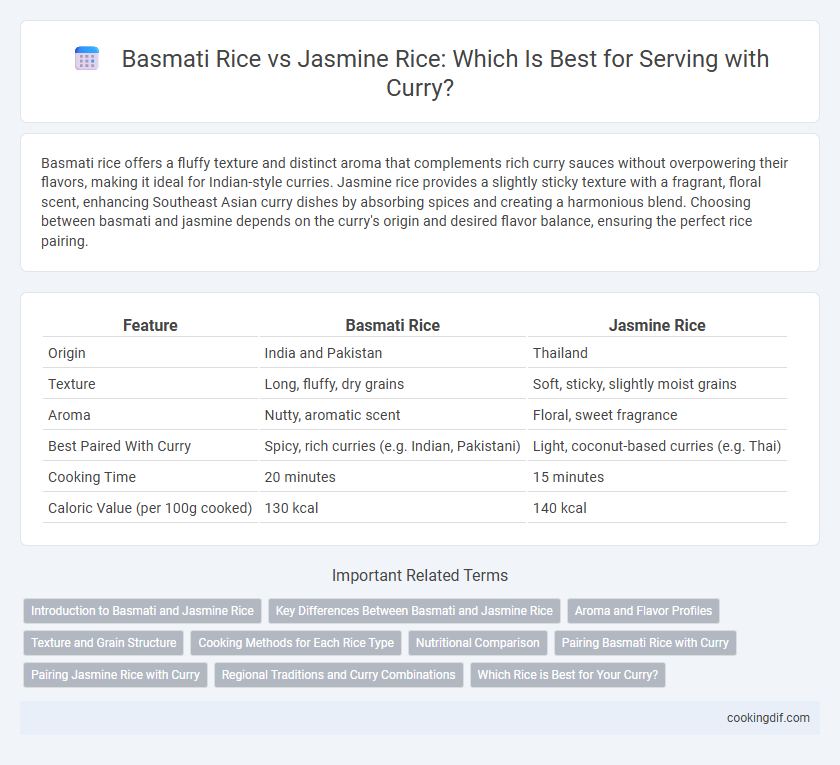Basmati rice offers a fluffy texture and distinct aroma that complements rich curry sauces without overpowering their flavors, making it ideal for Indian-style curries. Jasmine rice provides a slightly sticky texture with a fragrant, floral scent, enhancing Southeast Asian curry dishes by absorbing spices and creating a harmonious blend. Choosing between basmati and jasmine depends on the curry's origin and desired flavor balance, ensuring the perfect rice pairing.
Table of Comparison
| Feature | Basmati Rice | Jasmine Rice |
|---|---|---|
| Origin | India and Pakistan | Thailand |
| Texture | Long, fluffy, dry grains | Soft, sticky, slightly moist grains |
| Aroma | Nutty, aromatic scent | Floral, sweet fragrance |
| Best Paired With Curry | Spicy, rich curries (e.g. Indian, Pakistani) | Light, coconut-based curries (e.g. Thai) |
| Cooking Time | 20 minutes | 15 minutes |
| Caloric Value (per 100g cooked) | 130 kcal | 140 kcal |
Introduction to Basmati and Jasmine Rice
Basmati rice, grown primarily in the Indian subcontinent, is prized for its long, slender grains and aromatic fragrance that complements rich, spicy curries. Jasmine rice, native to Thailand, features shorter, plumper grains with a naturally sweet aroma and a soft, sticky texture, enhancing the harmony of Southeast Asian curry dishes. Both varieties offer unique flavors and textures that influence the overall curry experience, making the choice dependent on regional cuisine and personal preference.
Key Differences Between Basmati and Jasmine Rice
Basmati rice features long, slender grains with a distinct nutty aroma and a fluffy, non-sticky texture ideal for absorbing curry sauces without becoming mushy. Jasmine rice, known for its shorter grains and fragrant floral scent, offers a softer, slightly sticky texture that complements creamy curries and dishes with rich gravies. The key differences lie in their aroma, grain length, and texture, influencing their suitability for various types of curry preparations.
Aroma and Flavor Profiles
Basmati rice offers a distinct, nutty aroma with a dry, fluffy texture that complements rich, spicy curries by absorbing their flavors without becoming mushy. Jasmine rice features a subtly sweet, floral scent and a slightly sticky texture, enhancing creamy or mildly spiced curries with its delicate fragrance. Choosing between Basmati and Jasmine rice depends on the curry's intensity and preferred aroma balance to create a harmonious dining experience.
Texture and Grain Structure
Basmati rice offers long, slender grains with a fluffy texture that absorbs curry sauces well without becoming sticky, making it ideal for hearty Indian curries. Jasmine rice has shorter, slightly sticky grains with a soft and moist texture that complements Thai and Southeast Asian curry dishes by providing a subtly fragrant base. The grain structure of basmati maintains separation after cooking, whereas jasmine rice clumps slightly, enhancing the overall mouthfeel with creamy curries.
Cooking Methods for Each Rice Type
Basmati rice requires a soaking period of 20-30 minutes before cooking and is best prepared using the absorption method, which involves simmering the rice with a precise water-to-rice ratio to achieve fluffy, separate grains ideal for curry dishes. Jasmine rice, known for its naturally sticky texture, benefits from a slightly higher water ratio and short soaking or rinsing before cooking, often utilizing a steaming or boiling method to retain its fragrant aroma and soft consistency. Both methods enhance the pairing of each rice type with curry, ensuring optimal flavor absorption and texture contrast.
Nutritional Comparison
Basmati rice offers a lower glycemic index compared to Jasmine rice, making it a healthier option for those managing blood sugar levels when serving curry. Rich in fiber and protein, Basmati supports better digestion and sustained energy, while Jasmine rice contains slightly more calories and carbohydrates. Choosing Basmati rice enhances the nutritional profile of a curry meal by providing essential nutrients with fewer calories.
Pairing Basmati Rice with Curry
Basmati rice offers a fluffy texture and distinct nutty flavor that complements the robust spices in curry dishes, enhancing the overall taste experience. Its long, separate grains absorb curry sauces without becoming mushy, making it ideal for serving with Indian-style curries like chicken tikka masala or lamb rogan josh. The aromatic qualities of basmati rice also balance the heat and complexity of curry spices, creating a harmonious and flavorful meal.
Pairing Jasmine Rice with Curry
Jasmine rice pairs exceptionally well with curry due to its soft, slightly sticky texture that soaks up rich, flavorful sauces without overpowering them. Its delicate floral aroma complements the spices in curry, enhancing the overall dining experience. Unlike the nutty, separate grains of Basmati rice, Jasmine rice's moist consistency creates a harmonious balance with creamy and saucy curry dishes.
Regional Traditions and Curry Combinations
Basmati rice, prized in Indian and Pakistani cuisine, pairs well with rich, spicy curries like butter chicken and lamb rogan josh, as its long grains and fragrant aroma absorb sauces without clumping. Jasmine rice, a staple in Southeast Asian countries such as Thailand and Vietnam, complements lighter, coconut-based curries like Thai green curry and Massaman due to its slightly sticky texture and floral scent. Understanding these regional traditions enhances curry combinations, ensuring the rice not only supports but elevates the overall flavor profile.
Which Rice is Best for Your Curry?
Basmati rice, with its long, slender grains and aromatic fragrance, is ideal for Indian curries due to its fluffy texture that absorbs rich, spicy sauces without becoming mushy. Jasmine rice, featuring shorter, slightly sticky grains and a subtle floral aroma, pairs well with Thai and Southeast Asian curries, complementing their creamy, coconut-based flavors. Choosing between Basmati and Jasmine rice depends on the curry style; Basmati enhances robust, dry or tomato-based curries while Jasmine rice suits saucier, aromatic curries for a balanced meal experience.
Basmati rice vs Jasmine rice for serving curry Infographic

 cookingdif.com
cookingdif.com